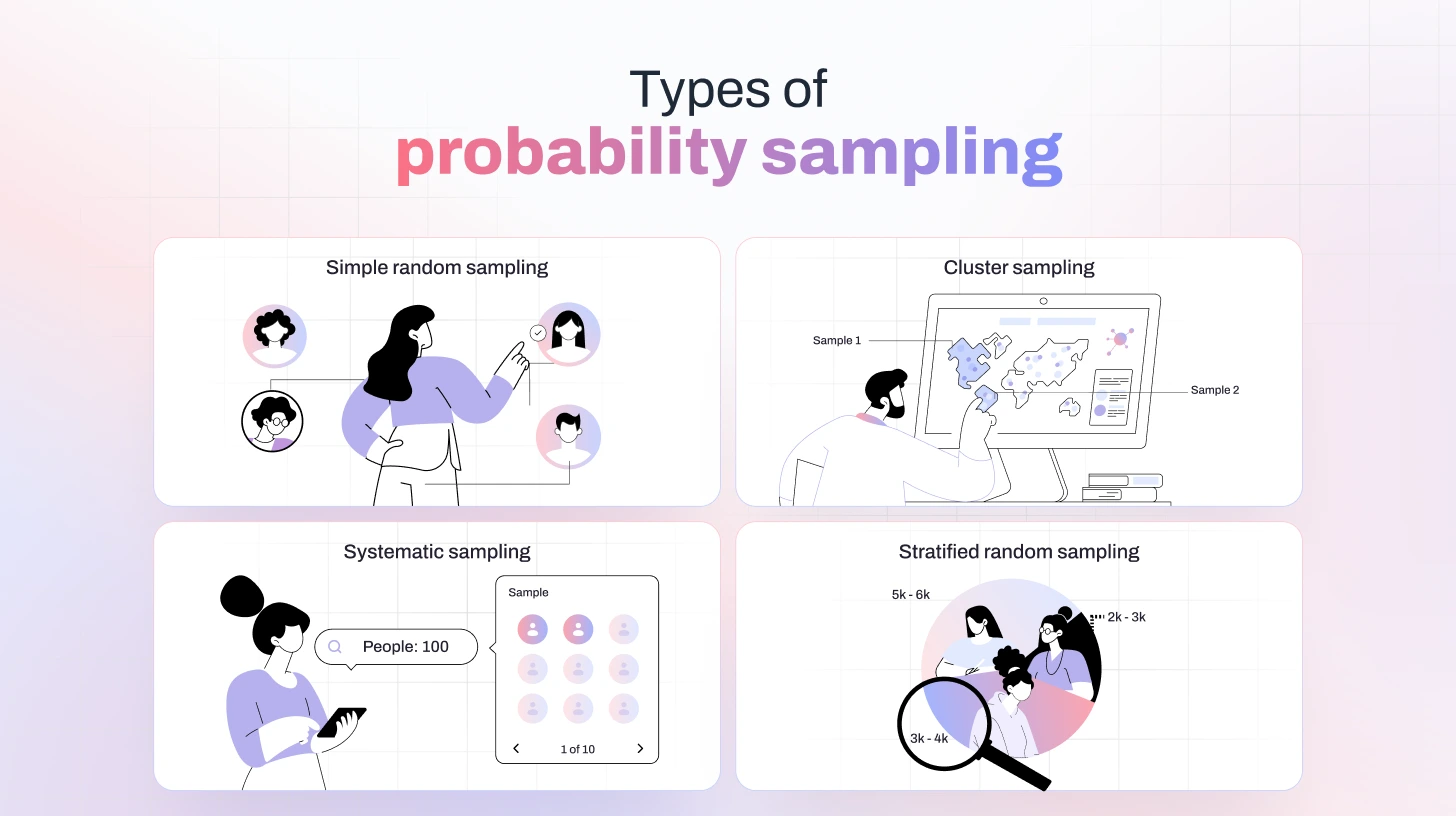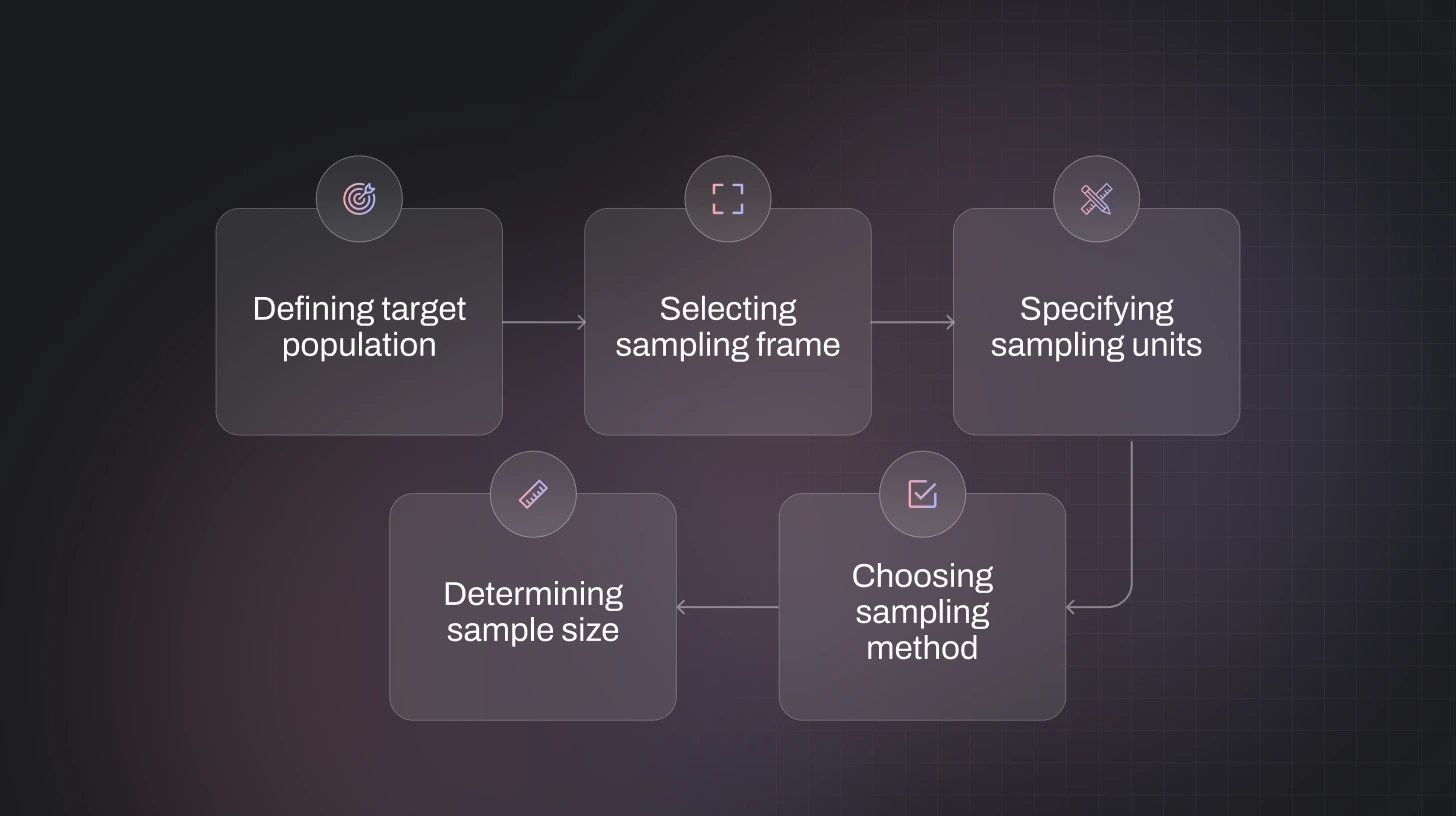 Blog
Blog Sampling Design Explained: Steps, Challenges, and AI Solutions
Sampling Design Explained: Steps, Challenges, and AI SolutionsSampling Design Explained: Steps, Challenges, and AI Solutions

Sampling design might sound technical, but at its core, it’s about answering one key question: Who should be included in your research?
The truth is, no study can realistically survey an entire population. That’s where sampling design comes in. By carefully choosing a representative subset of people, researchers can collect data that reflects the bigger picture without interviewing everyone.
Get sampling design right, and your results will be reliable, meaningful, and generalizable. Get it wrong, and you risk biased findings that don’t reflect reality.
This guide breaks down the importance of sampling design, different types, steps to create a plan, challenges, and how modern AI tools like TheySaid make the process easier.
TLDR
Sampling design is the backbone of good research. It determines who you ask, how many people you include, and how you choose them. The right design reduces bias, saves time, and improves accuracy. There are two main categories: probability sampling (random, fair, generalizable) and non-probability sampling (convenient, targeted, less generalizable). With AI tools like TheySaid, you can now minimize sampling errors, automate participant selection, and collect more reliable data in real time.
Read: Everything You Need to Know About Survey Sampling in Research and Business
Understanding the Importance of Sampling Design
Sampling design serves as the bridge between research theory and actionable insights. A strong design lets researchers capture the essence of a population without surveying every individual. Instead of spreading resources thin, a representative sample provides the clarity and depth needed to answer research questions effectively.
The benefits go beyond efficiency. A robust sampling design safeguards the credibility of findings. By making informed choices about who is included, researchers can reduce bias, improve accuracy, and draw conclusions that extend beyond the sample to the broader population.
In many ways, sampling design shapes the reliability of the entire research process. It ensures that the study is not just faster and cheaper, but also meaningful.
Read - Guide to Stratified Random Sampling for Researchers
Defining Sampling Design
At its core, sampling design is the blueprint for selecting research participants. It answers questions like:
- Who belongs in the study?
- How will they be chosen?
- What size should the sample be to ensure accuracy?
An effective sampling design reflects both the goals of the study and the nature of the population being examined. For example, a national health survey will require a more structured design than a quick feedback poll from university students.
Key decisions within sampling design include defining the target population, choosing between probability and non-probability methods, and determining the sample size. Each choice directly influences the quality and trustworthiness of the findings.
The Role of Sampling in Achieving Reliable Results
The reliability of research outcomes depends heavily on how well the sample reflects the population. A well-constructed sampling design ensures that data collected from a smaller group mirrors the characteristics of the larger whole.
Consider two scenarios:
- In the first, a political poll surveys only urban residents.
- In the second, the survey includes both urban and rural communities, proportional to their presence in the population.
Only the second design offers insights that truly represent the wider population. Sampling, therefore, isn’t just about convenience; it’s about ensuring fairness, accuracy, and trust in the research process.
When the sampling design is ignored or poorly executed, the consequences are significant: skewed findings, flawed interpretations, and decisions built on shaky ground.
Designing an Effective Sampling Strategy
Creating a sampling design requires more than random selection; it demands strategy. The first step is defining the target population clearly. Are you studying high school students in one city, or all adults across a country? Clarity here guides every other decision.
Next, researchers decide how participants will be chosen. Will it be a random process where everyone has an equal chance, or a more deliberate method focusing on specific groups? The answer depends on the research objectives.
Finally, the question of sample size arises. Too small a sample risks inaccuracy, while unnecessarily large samples waste resources. Striking the right balance ensures both statistical validity and practical feasibility.
An effective sampling strategy, therefore, blends clarity, representativeness, and efficiency.
Read - Guide to Random Sampling Methods and Techniques
Types of Sampling Design
Sampling designs are generally divided into two categories: probability sampling and non-probability sampling.
Probability Sampling
In probability sampling, every individual in the population has a known, non-zero chance of being selected. This method is widely regarded as the gold standard because it allows for stronger generalizations.
- Simple Random Sampling gives everyone an equal chance of selection.
- Systematic Sampling selects participants at regular intervals from a list.
- Stratified Sampling divides the population into subgroups and samples from each.
- Cluster Sampling selects entire groups, or clusters, such as schools or neighborhoods.

Non-Probability Sampling
Here, participants are chosen based on accessibility or the researcher's judgment, meaning not everyone has a chance to be included. While less rigorous, it is often more practical.
- Convenience Sampling relies on whoever is easiest to reach.
- Quota Sampling ensures certain categories are represented, but without randomization.
- Purposive Sampling targets individuals with specific knowledge or traits.
- Snowball Sampling recruits participants through referrals, useful in niche or hard-to-reach groups.

The choice between probability and non-probability methods depends on the research goals, available resources, and required accuracy.
Read: Probability vs Non-Probability Sampling: A Complete Guide for Researchers
Criteria for Choosing the Right Sampling Type
Selecting the right sampling design is not a one-size-fits-all decision. Several factors shape the choice:
- Research Objectives: Exploratory studies may tolerate less rigorous designs, while high-stakes research demands precision.
- Population Size and Diversity: Larger, more diverse groups often require probability-based methods.
- Resources: Budget, time, and personnel can limit the feasibility of certain designs.
- Accuracy Needs: If decisions hinge on precise results, more rigorous sampling is essential.
By weighing these criteria, researchers can align their design with both their goals and constraints.
Implementing Your Sampling Design
Once the design is planned, the next challenge is execution. Implementation begins with defining inclusion and exclusion criteria, ensuring that the sample aligns with the target population. For instance, a study on employee satisfaction might include full-time staff but exclude interns.
After this, researchers apply the chosen method, random, stratified, purposive, or otherwise, to select participants. Careful monitoring is essential to prevent bias from creeping in during execution. Finally, researchers must assess the representativeness of the sample and make adjustments if necessary.
Implementation isn’t just about following steps; it’s about maintaining discipline and consistency so that the final data holds up to scrutiny.
Steps in Developing a Sampling Plan
A structured plan is vital to transform theory into practice. Developing a sampling plan typically involves:
- Defining clear research objectives.
- Identifying the target population.
- Creating a sampling frame, a list of all potential participants.
- Choosing the sampling method.
- Determining the sample size.
- Selecting participants systematically.
- Collecting and validating the data.
Each step strengthens the integrity of the research, ensuring the final dataset reflects the population as accurately as possible.

Challenges and Solutions in Sampling Design
No sampling design is without hurdles. Common challenges include:
- Representativeness: Capturing the true diversity of the population can be difficult. Solutions include stratified sampling and careful sample frame construction.
- Accessibility: Some groups are hard to reach. Online surveys and digital tools help broaden access.
- Bias: Even unconscious choices can skew results. Randomization and neutral selection criteria are essential safeguards.
- Resource Constraints: Time and budget often limit possibilities. Creative compromises, like cluster sampling, can reduce costs without sacrificing too much accuracy.
Acknowledging these challenges and proactively addressing them ensures stronger research outcomes.
Read: Sampling Error Explained: Definition, Types, and How to Reduce It
The Role of AI in Sampling Design
Traditional sampling requires lots of manual work, choosing methods, checking representativeness, and validating accuracy. This is where AI is changing the game:
- Smarter Sample Selection – AI can scan massive datasets to identify the most representative participants.
- Bias Detection – Algorithms can flag skewed samples in real time.
- Predictive Adjustments – AI can predict which participants are likely to respond and adjust accordingly.
- Dynamic Sampling – Instead of a static sample, AI allows researchers to adapt their sample based on live feedback.
The Future of Sampling Design with AI (and Why TheySaid Leads the Way)
Sampling design has always been about striking the right balance among accuracy, fairness, and efficiency. But with today’s fast-moving research needs, traditional methods can feel slow and limited. That’s where AI-driven tools like TheySaid step in.
TheySaid doesn’t just help you collect responses; it helps you collect the right responses. By using AI to reduce bias, optimize sample selection, and adapt in real time, TheySaid ensures your surveys reflect the bigger picture with unmatched accuracy.
If you want your research to go beyond checkboxes and deliver insights you can actually trust, it’s time to rethink how you design your samples. With TheySaid, you don’t just design a survey, you start a smarter conversation with the people who matter most.
FAQs
How do I know which sampling design to use?
It depends on your research goals, budget, and whether you need results that represent the entire population or just quick, directional insights.
What are common mistakes in sampling design?
Surveying too few people, relying only on convenience samples, ignoring diversity, and not checking for sampling errors.
What happens if I don’t use a proper sampling method?
You risk collecting skewed data that doesn’t reflect reality, leading to poor decisions based on faulty insights.















.svg)